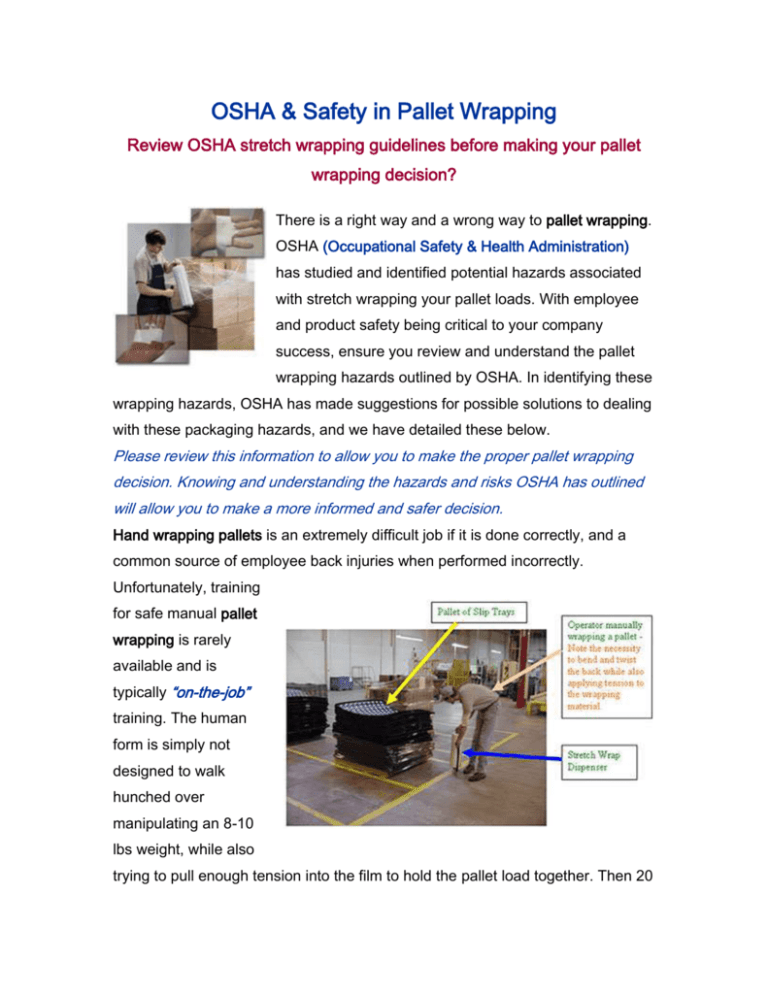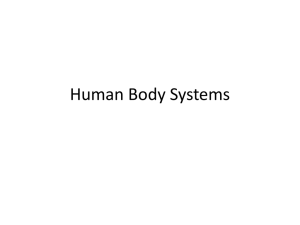OSHA & Safety in Pallet Wrapping
advertisement

OSHA & Safety in Pallet Wrapping Review OSHA stretch wrapping guidelines before making your pallet wrapping decision? There is a right way and a wrong way to pallet wrapping. OSHA (Occupational Safety & Health Administration) has studied and identified potential hazards associated with stretch wrapping your pallet loads. With employee and product safety being critical to your company success, ensure you review and understand the pallet wrapping hazards outlined by OSHA. In identifying these wrapping hazards, OSHA has made suggestions for possible solutions to dealing with these packaging hazards, and we have detailed these below. Please review this information to allow you to make the proper pallet wrapping decision. Knowing and understanding the hazards and risks OSHA has outlined will allow you to make a more informed and safer decision. Hand wrapping pallets is an extremely difficult job if it is done correctly, and a common source of employee back injuries when performed incorrectly. Unfortunately, training for safe manual pallet wrapping is rarely available and is typically “on-the-job” training. The human form is simply not designed to walk hunched over manipulating an 8-10 lbs weight, while also trying to pull enough tension into the film to hold the pallet load together. Then 20 seconds later you are holding the same roll of stretch film above your head to do the top of the pallet, again tugging on the film using only your back and arm muscles. This arduous task put employees at risk of developing musculoskeletal disorders (MSDs). OSHA notes that many accidents and work related injuries are caused by hand wrapping pallets. The cost of these work related accidents are never considered until it is too late. Keep your employees on the job while saving time and money. The following information was produced by the Occupational Safety & Health Administration (OSHA) and is available on their website (www.osha.gov ). U.S. Department of Labor Occupational Safety & Health Administration (OSHA) Potential Hazards: After a load has been built, it is generally wrapped with plastic to maintain its integrity during transit. Employees may be injured when performing this task manually. They must bend at the waist to wrap the bottom of the pallets while supporting the plastic dispenser (Fig. 11). Employees often stick their fingers into the open end of the tubes to stream off the wrap. This increases the risk of cuts to the fingers. Fig.11: Employee wrapping pallet. Possible Solutions: Use an automatic plastic wrapping machine with palletized product sitting on a turntable (Fig. 12). This ensures the employee will not have to bend at the waist to wrap the pallet. If manual wrapping must be performed, use rolls that weigh as little as possible to minimize the lifting hazard. Fig. 12: Wrapping Machine. A handle (Fig. 13) will prevent employees from placing their fingers into the tube, thus decreasing the risk of cuts. Fig. 13: Manual Wrapper. OSHA Case Study Success with Ergonomics The following case study performed by OSHA highlights the issues concerning pal wrapping and is available online at www.osha.gov U.S. Department of Labor Occupational Safety & Health Administration State: Illinois Company: Advanced Filtration Systems Inc. Industry: Manufacture of Diesel Engine Filters Employees: 164 SIC Code: 3599 NAICS Code: 336339 Success Brief: The installation of a Semi-Automatic Stretch Wrapper substantially reduced the risk of ergonomic injury, while increasing production and improving employee morale. The Problem During a production trial, manual stretch wrapping of pallets of empty reusable slip trays required compound motions and awkward body postures that would have put employees at risk of developing musculoskeletal disorders (MSDs). The process required employees to wrap the pallets 8 to 10 times using a manual wrap dispenser weighing approximately 30 to 35 pounds (See Picture #1 below of manual stretch wrapping operation). During the trial, at least one employee complained of back pains. The Solution The company purchased and installed a Semi-Automatic Stretch Wrapper machine that performs most of the ergonomically hazardous work involved in stretch wrapping the pallets of empty reusable slip trays prior to shipping. The machine includes a rotating stand and vertical lift for the pallets, along with a wrap dispenser and lift chain guarding that moves with the pallet (See Picture #2 below of “Semi-Automatic Stretch Wrapper”). Once the stretch wrapper was installed, the company improved the machine's guarding and placed warning barriers on each side as further safety precautions. The Impact The Semi-Automatic Stretch Wrapper has significantly decreased the risk of MSDs to the facility personnel responsible for preparing pallets for shipment. Since the machine's installation, there have been no reports of back pain, pain in other body parts, or any other MSD symptoms from these employees. The machine has also increased production efficiency, since it uses less wrap and is 3 to 4 times faster than manual stretch wrapping. Employee morale has also increased as a result of the new process. Source: Mr. Richard Jesse, Associate Environmental Engineer, Advanced Filtration Systems, Inc. (October 2003).





![Wrapping Machine [VP] OPP film wrapping for flat](http://s2.studylib.net/store/data/005550216_1-6280112292e4337f148ac93f5e8746a4-300x300.png)